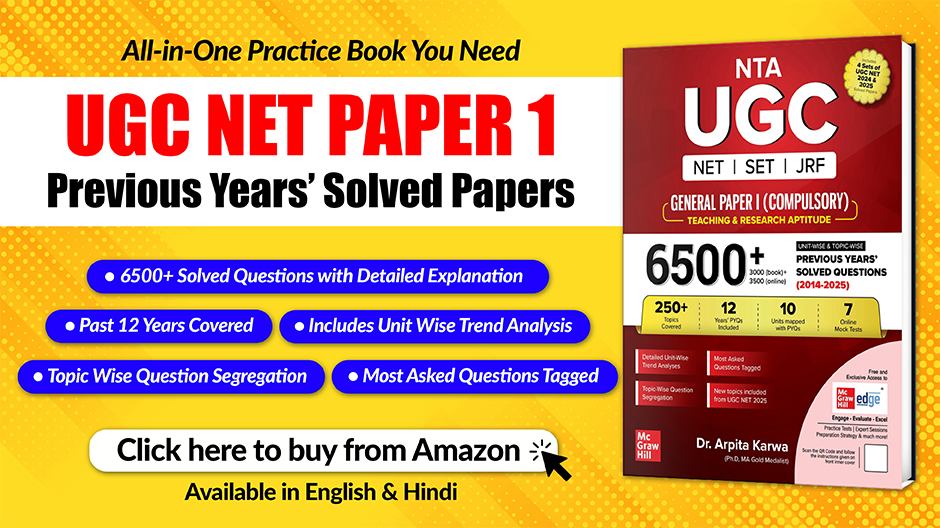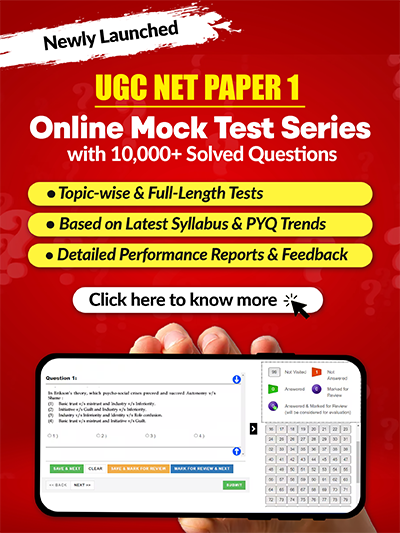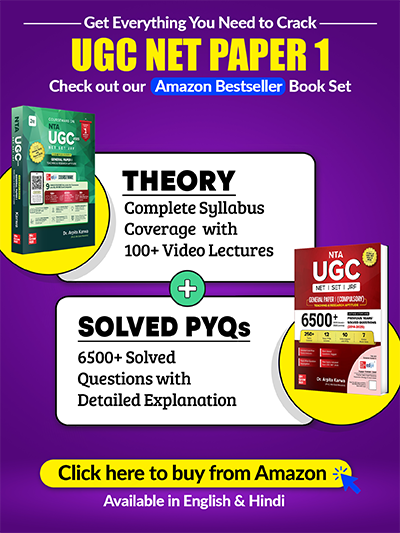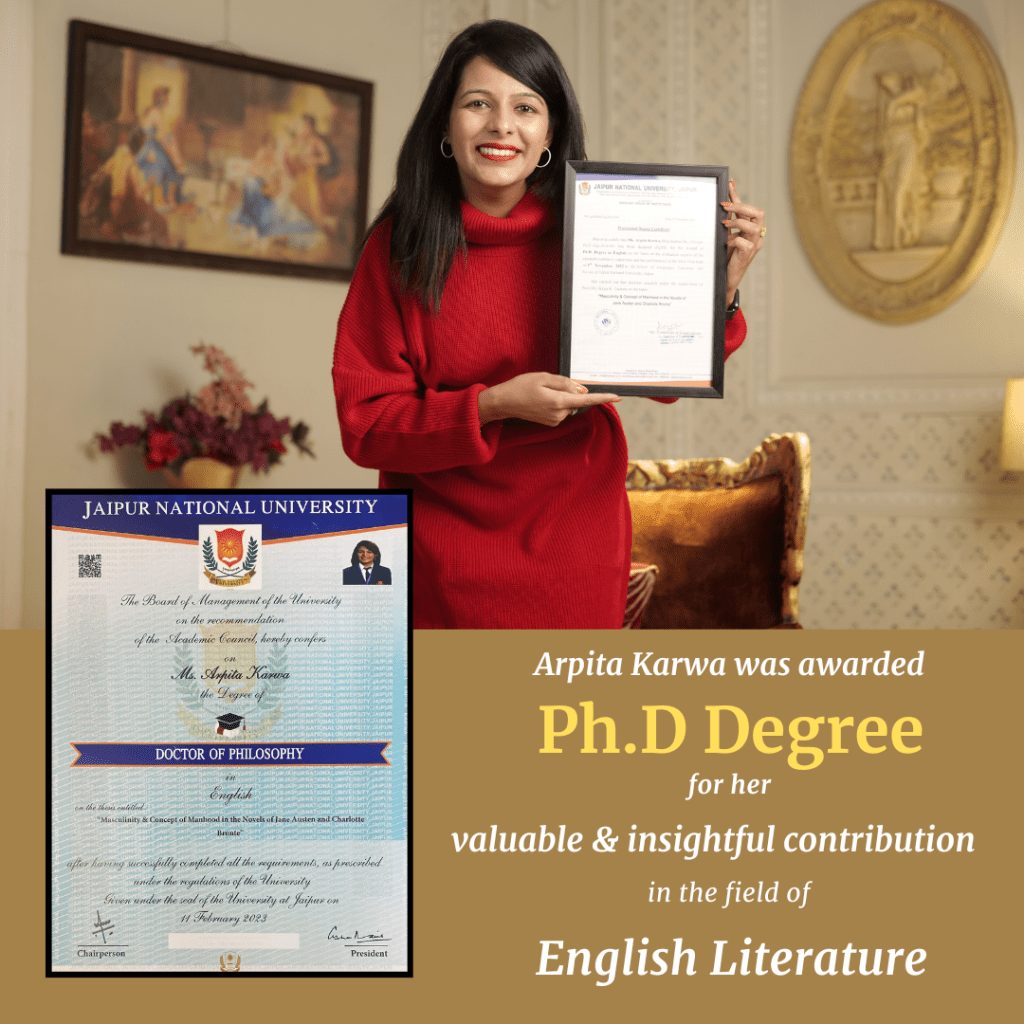UGC NET Paper 1 September 2020 (Conducted on 25th Sep 2020 : Evening Shift)
October 19, 2022 2025-08-18 13:43UGC NET Paper 1 September 2020 (Conducted on 25th Sep 2020 : Evening Shift)
September 2020: Paper 1 (Conducted on 25th Sep 2020 : Evening Shift)
Q.1) From the list given below, identify those features which relate to an approach to teaching and learning in indirect strategies of teaching
A. Engagement in an inquiring process
B. Concept-based content presentation
C. Gaining attention and informing the learners of the instructional objective
D. Presenting the stimulus material and stimulating recall of prerequisite learning
E. Encouraging students to use references from their own experiences
[1] ABC
[2] BCD
[3] ABE
[4] CDE
Correct Answer: 3
Q.2) Statement I: Reliability is a necessary but insufficient condition for validity
Statement II: In respect of evaluation tools, validity is not an all or none concept but it exists as a continuum
[1] Both Statement I and Statement II are true
[2] Both Statement I and Statement II are false
[3] Statement I is true but Statement II is false
[4] Statement I is false but Statement II is true
Correct Answer: 1
Q.3) Assertion A: Systems of education which are place-specific, time-specific and person-specific are said to be formal and are created by laid down law and procedures
Reason R: Open universities and open schools are the example of a formal system of education because they are created by laid down procedures
[1] Both A and R are true and Ris the correct explanation of A
[2] Both A and R are true but R is NOT the correct explanation of A
[3] A is true but R is false
[4] A is false but R is true
Correct Answer: 3
Q.4) Which of the following methods of acquiring knowledge save time and effort on the part of the researcher?
[1] Method of experience
[2] Inductive method
[3] Deductive method
[4] Method of consulting an authority
Correct Answer: 4
Q.5) Which of the following are features of the qualitative research paradigm?
A. The research is concerned with understanding the social phenomena from the participant’s perspective
B. It seeks to establish relationships, among variables and explains the causes of changes in measured social facts
C.It is conducted in actual settings as the direct source of data and the researcher is the key instrument
D. It is concerned with the process rather than simply with outcomes of products
E. It attempts to establish universal context-free generalization
[1] ABC
[2] BCD
[3] ACD
[4] CDE
Correct Answer: 3
Q.6) A researcher administers an achievement test to assess and indicate the possible effect of an independent variable in his/her study. The distribution of scores on the test is found to be negatively skewed. On the basis of this, what can be stated with regard to the difficulty level of the test?
[1] The test is very easy
[2] The test is very difficult
[3] The test is neither easy nor difficult
[4] The test is easy and needs normalization
Correct Answer: 1
Q.7) Assertion A: A researcher has to observe codal formalities at all stages without scope and leeway for offending moral and ethical norms
Reason R: In respect of data collection, data analysis and interpretation there is, however, a considerable scope of being ethically vulnerable
[1] Both A and R are true and R is the correct explanation of A
[2] Both A and R are true but R is NOT the correct explanation of A
[3] A is true but R is false
[4] A is false but R is true
Correct Answer: 1
Q.8) The scope for employing ICT support is relatively more in which of the following stages of research?
A. Problem formulation
B. Hypothesis making
C. Data collection
D. Data analysis
E. Data interpretation
[1] AB
[2] BD
[3] CD
[4] DE
Correct Answer: 3
Q.9-13) Read RC Passage to Answer:
According to Richard Beckhard, a transformation represents a vital organizational change. Transformation is characterized by certain features that clearly differentiate it from other types of change. First, according to Beckhard, it involves substantial and discontinuous change to the shape, structure, and nature of the organization, rather than incremental adjustments and fine-tuning of the current situation. One example of a discontinuous change would be when a firm changes from being production-driven to being customer-driven. Another would be a merger of two organizations. In both instances, the shape of the organization can be expected to change radically. An organization transforming from a production orientation to a customer orientation will need to drastically decentralize and delegate authority. In a merger, entirely new roles and working relationships will be created.
A second characteristic of transformation is that the need for change is caused by forces external to the organization rather than forces inside the organization. A typical example would be when an organization changes from a functional to a divisional structure in response to market forces or industry pressures in the form of competitor actions or regulatory changes. Currently, globalization is one of the most powerful external forces for organizational transformation.
A third distinguishing feature of transformation is that the change is deep and pervasive, rather than shallow and contained. The change affects all parts of the organization and involves many levels. Decentralization, downsizing and the geographic relocation of functions and activities exemplify changes that transform structural relationships deeply and pervasively.
Finally, transformation requires significantly different, and even entirely new, sets of actions by the members of the organization, rather than more or less of existing behavior patterns. Examples are changes to the norms and core values of an organization that are brought about through acquisition, deregulation, and privatization or through a drastic strategic repositioning such as shifting from a production-efficiency focus to a customer-service strategy.
Q.9) According to Richard Beckhard, transformation is what kind of change in the organisational structure?
[1] Incremental
[2] Discontinuous
[3] Finetuning
[4] One-time
Correct Answer: 2
Q.10) What happens when two organisations merge?
A. Shape of the organisation will change
B. Product orientation remains the same
C. Drastic decentralisation of authority
D. Discontinuous change does not take place
[1] AB
[2] BC
[3] CD
[4] AC
Correct Answer: 4
Q.11) The pressure of market force can result in-
[1] Distortion of role perceptions
[2] Changing to a functional structure
[3] Changing to a divisional structure
[4] Deregulation of competitive factors
Correct Answer: 3
Q.12) What are the main levels of organizational transformation?
A. Downsizing
B. Geographical relocation
C. Contained changes
D. Power to external forces
[1] AB
[2] BC
[3] CD
[4] AD
Correct Answer: 1
Q.13) What does organizational transformation require? *
[1] Strengthening existing behaviours of members
[2] Changes in norms and core values
[3] Production-efficiency strategy
[4] All pervasive structural relationships
Correct Answer: 2
Q.14) The domain of media appeal addresses the issues related to
[1] Knowledge
[2] Learning
[3] Legality
[4] Emotions
Correct Answer: 4
Q.15) Which of the following will make a student a good listener in the classroom?
A. Ability to deflect attention
B. Concentration
C. Desire to understand
D. Emotional outbursts
E. Humility to know
F. Ignoring the other side
[1] ABC
[2] BCD
[3] DEF
[4] BCE
Correct Answer: 4
Q.16) Assertion A: Pedagogy and social interaction are two major areas of activity of teachers
Reason R: It is communication that is crucial for making both the activities important
[1] Both A and R are true and R is the correct explanation of A
[2] Both A and R are true but R is NOT the correct explanation of A
[3] A is true but R is false
[4] A is false but R is true
Correct Answer: 1
Q.17) Match the column:
A. Poor listeners
B. Aggressive listeners
C. Passive listeners
D. Pseudo-intellectual
I. Scare others
II. Easily agree with the speaker
III. Listen to ideas, but no emotions behind
IV. Fidget repeatedly
[1] A-I B-II C-III D-IV
[2] A-II B-III C-IV D-I
[3] A-III B-IV C-I D-II
[4] A-IV B-I C-II D-III
Correct Answer: 4
Q.18) Find out the correct chronological order of the following educational communication ventures in India
A. Krishi Darshan
B. Gyan Darshan
C. Vyas
D. Gyan Vani
[1] ABCD
[2] BCDA
[3] DABC
[4] ADBC
Correct Answer: 4
Q.19) The difference of the square of two consecutive even numbers is 8[4] What is the sum of these two consecutive even numbers?
[1] 34
[2] 38
[3] 36
[4] 42
Correct Answer: 4
Q.20) Identify the next term in the series-
0,8,24,48__
[1] 72
[2] 96
[3] 120
[4] 80
Correct Answer: 4
Q.21) Mr X is 40 years old and Mr Y is 60 years old. How many years ago was the ratio of their ages 3:5?
[1] 15 years
[2] 10 years
[3] 20 years
[4] 30 years
Correct Answer: 2
Q.22) In a river from a fixed location, two identical boats start moving upstream and downstream, respectively. The speed of the water current in the river is 3 km/hour. If the speed of each of the boats in still water is 15 km/hour, the separation between the boats after 12 minutes will be
[1] 3.6 km
[2] 5.6 km
[3] 6.0 km
[4] 7.2 km
Correct Answer: 3
Q.23) Consider the following letter series and identify the next term
ace, fhj, kmo, __
[1] npr
[2] rty
[3] prt
[4] uwy
Correct Answer: 3
Q.24) Match the column:
A. Episteme and Doxa
B. Potential and Actual being
C. Vyavaharika and Parmarthik
D. Rational and Actual
I. Aristotle
II. Hegel
III. Sankara
IV. Plato
[1] A-I B-II C-III D-IV
[2] A-II B-III C-IV D-I
[3] A-III B-IV C-II D-I
[4] A-IV B-I C-III D-II
Correct Answer: 4
Q.25) What type of cognition is beyond the ambit of perception?
[1] Anumiti
[2] Upamiti
[3] Nirvikalpaka pratyaksha
[4] Savikarpaka pratyaksha
Correct Answer: 3
Q.26) “Golden mountain is fiery because it is smoky’
Which type of fallacy is committed by the above inference?
[1] Asraya siddhi
[2] Svarapa siddhi
[3] Vyapyatva siddhi
[4] Savyabhichara
Correct Answer: 1
Q.27) In a proposition which is particular affirmative,
[1] Subject term is distributed but the predicate is not distributed
[2] Neither the subject nor the predicate is distributed
[3] Both subject and predicate are distributed
[4] Subject is undistributed but predicate is distributed
Correct Answer: 2
Q.28) Match the column:
A. Abhava
B. Anupalabdhi
C. Apoha
D. Syadavada
I. Jainism
II. Buddhism
III. Vedanta
IV. Nyaya
[1] A-II B-III C-I D-IV
[2] A-III B-IV C-II D-I
[3] A-IV B-III C-II D-I
[4] A-I B-II C-IV D-III
Correct Answer: 3
Q.29-33)
Q.29) What are the average percentage of marks (%) obtained by all the seven students in Physics?
[1] ~82.42
[2] ~74.28
[3] ~86.24
[4] ~95.14
Correct Answer: 2
Q.30) The number of students who obtained 60% and above marks in all subject is:
[1] 4
[2] 5
[3] 2
[4] 1
Correct Answer: 3
Q.31) What are the aggregate of marks obtained by Mayank in all the six subjects?
[1]432
[2]456
[3]460
[4]440
Correct Answer: 4
Q.32) In which subject is the overall percentage the best?
[1] Computer Science
[2] Chemistry
[3] Math
[4] Physics
Correct Answer: 1
Q.33) What is the overall percentage of Ashish?
[1] 54%
[2] 68%
[3] 59.66%
[4] 63%
Correct Answer: 3
Q.34) What is the full form of the abbreviation ISP?
[1] International Service Provider
[2] Internet Service Provider
[3] Internet Software Provider
[4] Internet Service Product
Correct Answer: 2
Q.35) What is the name for a web page address?
[1] Directory
[2] Folder
[3] Domain
[4] URL
Correct Answer: 4
Q.36) Assertion A: Privacy and security of user data is at stake on the Internet
Reason R: No steps are being taken by the user for the security and privacy of data
[1] Both A and R are correct and R is the correct explanation of A
[2] Both A and R are correct but R is NOT the correct explanation of A
[3] A is correct but R is not correct
[4] A is not correct but R is correct
Correct Answer: 1
Q.37) Which of the following is excluded from the domain of Artificial Intelligence?
[1] Computer Vision
[2] Machine Learning
[3] Deep Leaming
[4] Text
Correct Answer: 2
Q.38) Which of the following are Millennium Development Goals?
A. Eradicating extreme poverty and hunger
B. Improving maternal health
C. Addressing climate change
D. Promoting gender equity and empowerment of women
E. Ensuring energy security for all
[1] ABCD
[2] ACDE
[3] ABCDE
[4] ABD
Correct Answer: 4
Q.39) Identify the correct sequence of energy sources in terms of their heat of combustion in increasing order
A. Methane
B. Natural fats and oils
C. Dry wood
D. Green wood
[1] ACBD
[2] DCBA
[3] DBCA
[4] DCAB
Correct Answer: 2
Q.40) Assertion A: Polluted rivers with very high values of Biological Oxygen Demand (BOD) may produce a foul smell
Reason R: Anaerobic bacteria produce sulphur dioxide and oxides of nitrogen
[1] Both A and R are correct and R is the correct explanation of A
[2] Both A and R are correct but R is NOT the correct explanation of A
[3] A is correct but R is not correct
[4] A is not correct but R is correct
Correct Answer: 3
Q.41) High hazard wastes may contain
A. Pathogens
B. Radioactive wastes
C. Non-reactive substances
D. Corrosive substances
[1] ABD
[2] ABCD
[3] BD
[4] ABC
Correct Answer: 1
Q.42) In the case of which of the following primary pollutants, the man-made contributions to global emissions (million tonnes per year) are more compared to that from natural sources?
[1] Sulphur dioxide
[2] Nitric oxide
[3] Methane
[4] Carbon dioxide
Correct Answer: 1
Q.43) In which of the Universities named below, correspondence courses were initiated in 1962?
[1] University of Madras
[2] University of Bombay
[3] University of Calcutta
[4] University of Delhi
Correct Answer: 4
Q.44) Which of the following areas of liberal education at the higher level in feudal society of Europe were classified under trivium?
A. Geometry
B. Astronomy
C. Grammar
D. Logic
E. Rhetoric
[1] ABC
[2] BCD
[3] CDE
[4] ADE
Correct Answer: 3
Q.45) Which of the following categories of colleges is primarily intended for creating work ready manpower on a large scale?
[1] Autonomous college
[2] Community college
[3] Agriculture college
[4] Technical college
Correct Answer: 2
Q.46) Synchronous communication takes place through which of the following technologies?
A. Video chat
B. Virtual classrooms
C. Audio conferencing
D.Wikis
E. Electronic mail
[1] ABC
[2] BCD
[3] CDE
[4] ADE
Correct Answer: 1
Q.47) Match the column:
A. Personal level
B. Professional level
C. Institutional level
D. Societal level
I. Democratic functioning in the higher education system and believing each individual worthy of attention
II. Standard of behaviour and ethics we adopt and develop for ourselves
III. Values which influence and cushion the operation of higher education
IV. Exercising personal and professional values within the concept of the higher education institution
[1] A-IV B-III C-I D-II
[2] A-II B-I C-IV D-III
[3] A-III B-IV C-II D-I
[4] A-I B-II C-III D-IV
Correct Answer: 2
























